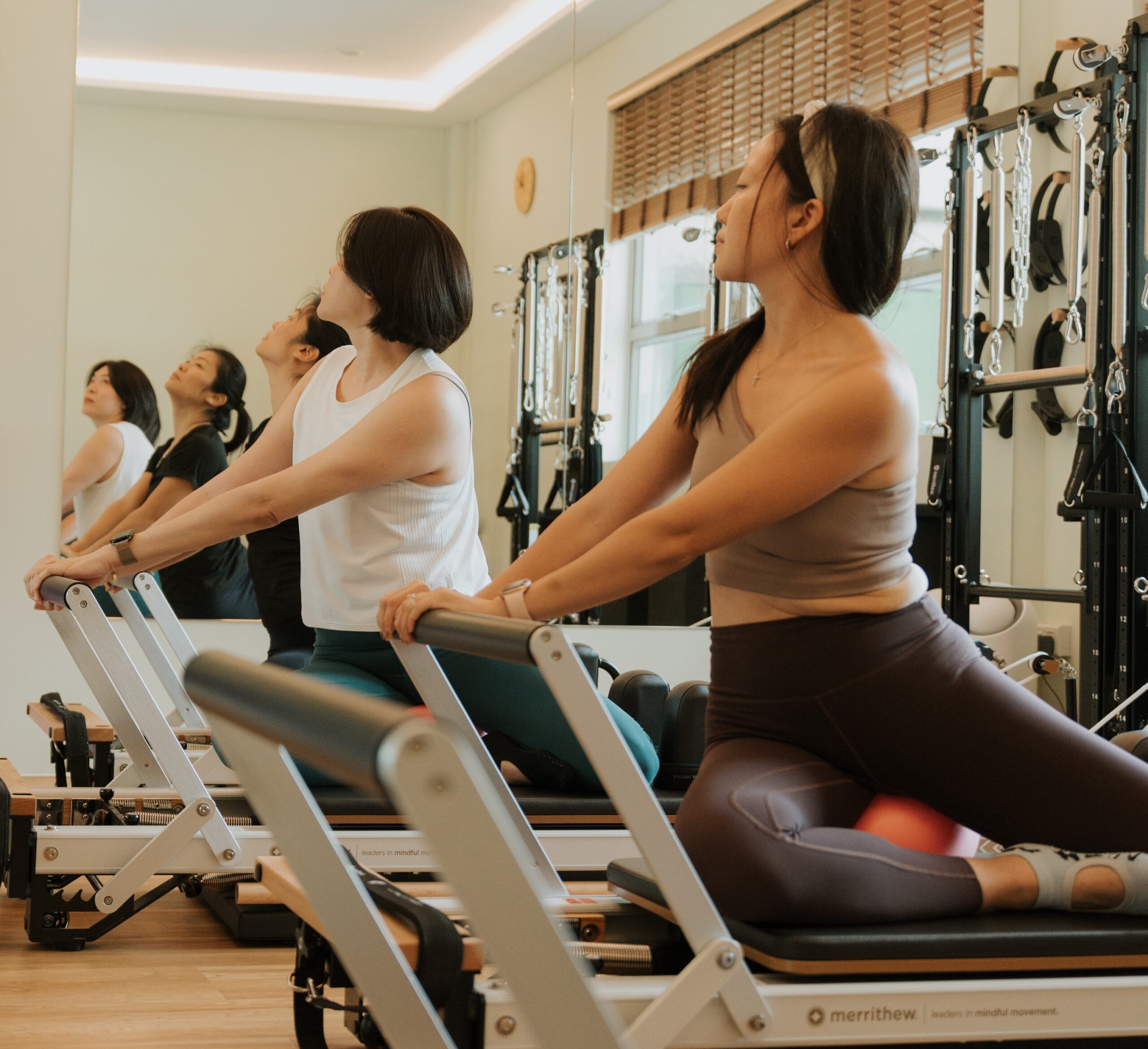Pregnancy and childbirth transform your body in powerful ways, but those changes often leave new mums wondering how and when they can safely return to exercise. At LIVE Pilates Singapore, we believe that recovery is not just about “bouncing back,” but about rebuilding strength, restoring function, and reconnecting with your body from the inside out.
In this post, we’ll explore how postnatal Pilates can support you in recovering from diastasis recti, strengthening your pelvic floor, and improving posture—all while helping you move with confidence in your new role as a mother.
What Happens to the Body During and After Pregnancy?
During pregnancy, your body undergoes significant structural and hormonal changes to support your growing baby. While these changes are natural, they often result in postpartum issues that require mindful rehabilitation.
Key Postpartum Concerns:
1. Pelvic Floor Dysfunction
The deepest core muscle that wraps around your torso like a corset, protecting the spine and stabilizing the pelvis.
2. Diastasis Recti
Diastasis recti refers to the separation of the abdominal muscles during pregnancy. Left unaddressed, it can contribute to back pain, poor posture, and a lingering “mummy tummy.”
3. Postural Changes
Carrying a baby during and after pregnancy shifts your center of gravity, often leading to rounded shoulders, tight hips, and strain on the lower back.
Why You Shouldn’t Rush Into Vigorous Postpartum Exercise
It’s tempting to dive into intense workouts to lose pregnancy weight. But jumping into high-impact exercise too soon can:
- Aggravate pelvic floor dysfunction
- Worsen diastasis recti
- Lead to injuries from joint instability and muscular imbalances
- Slow down your overall recovery
Remember: postpartum fitness should prioritise healing, not just aesthetics. Quick fixes can cause long-term setbacks.
How Pilates Helps With Postnatal Recovery
Postnatal Pilates offers a gentle, effective, and medically supported way to restore strength, stability, and confidence after birth. At LIVE Pilates Singapore, our instructors are trained to support postnatal clients in every stage of recovery.
1. Pilates Rebuilds Deep Core Strength

Toe taps are a simple yet powerful way to activate the deep core muscles. Though they may appear basic, they’re often essential for postnatal clients to safely rebuild core strength and pelvic floor function before progressing to more advanced exercises.
Begin by lying on your back in neutral spine with one foot flat on the mat and the other leg lifted into tabletop position.

From here, lower the tabletop leg toward the mat with control, keeping the knee bent at 90 degrees.
Focus on maintaining a stable pelvis and neutral spine throughout the movement.
This controlled action challenges the deep stabilizing muscles of the core, promoting better pelvic and spinal support, key elements in postnatal recovery and long-term core health.
2. Pilates Support Diastasis Recti Recovery
Our instructors guide you through movements that avoid *doming or straining your core. Over time, Pilates helps realign and restore the connective tissue between the abdominal muscles.
* Doming is a visible bulge along the midline of the abdomen that can occur during exercise, especially after pregnancy. It often indicates diastasis recti or poor core engagement. When doming appears, it’s a sign that the core muscles aren’t activating correctly and the movement should be modified to prevent further strain.

“The half roll-back is typically introduced after a few foundational sessions when proper pelvis and spinal control is demonstrated (such as in Toe Taps).
Begin seated upright, then gently roll the pelvis away from the thighs, using the abdominals to guide the tailbone down toward the pubic bone.

When first attempting the movement, clients should roll back gradually, ensuring the abdominals stay engaged without *doming, while exploring their range of motion and core strength with control.
Over time, they can progress to the full range as shown in the picture.

When sufficiently strong, clients can be further challenged by lifting the arms up to increase the demand on the core.
*All Progressions should be done all under the guidance of an experienced instructor.
3. Pilates Improves Posture and Alignment
We focus on exercises that realign the spine, strengthen the upper back, and relieve tension from feeding or carrying your baby.

In this classic arms pulling straps exercise, one starts by lying face down on the long box with the chest and upper back rounded slightly over the front edge. Legs stay long and parallel to the floor, and hands are holding the ropes.

Initiate the movement by lifting the head and chest into a long, straight line while pulling the arms down by your sides.
This gently engages the upper back muscles against gravity

Continue to pull the arms towards the hips while lifting the upper back further into spinal extension.
This strengthens the upper back and targets the posterior shoulder and arm muscles.
This is a great exercise for improving posture– especially those with rounded shoulders or a “sleepy” upper back.
4. Pilates Enhances Breathing and Mind-Body Awareness
Proper Pilates breathing re-educates your diaphragm and promotes natural core engagement, key in your postnatal healing journey.
5. Pilates facilitates Safe, Joint-Friendly Movement
Using reformers, towers, and bodyweight exercises, we create safe resistance that doesn’t jar your joints or put pressure on your pelvic floor.

Once a client has developed sufficient core stability, Baby Planks can be introduced to further challenge and strengthen the abdominals.
Start in a quadruped position with hands under shoulders, knees under hips, and pelvis in neutral.

Press the carriage out using the legs and glutes, maintaining a neutral spine and pelvis until the body forms a straight line from head to knees.

To increase the challenge, continue the movement by extending through the arms, only as far as the client can go while keeping proper alignment.
This variation remains gentle on the joints yet is highly effective at activating the deep core.
Adjust the range based on strength and control, ensuring form is never compromised. Repeat as needed.
Postnatal Pilates in Singapore: Why Choose LIVE Pilates?
At LIVE Pilates Singapore, we’re more than just a workout studio. We’re a peaceful, boutique space that supports holistic postpartum recovery—emotionally, mentally, and physically.
What Makes Our Postnatal Classes Different?
- Small class sizes (max 5 clients)
- STOTT Pilates trained instructors with experience in postnatal care
- Safe, progressive programs for every postpartum stage
- Focus on healing, strength, and long-term function—not just appearance
Whether you’re 6 weeks or 6 months postpartum, our goal is to help you feel strong, mobile, and confident in your new body.
When to Start Postnatal Pilates
You can typically begin gentle Pilates once your medical healthcare practitioner clears you—usually 4-6 weeks after vaginal birth or 6-8 weeks post-caesarean. Before starting, we recommend consulting a doctor or pelvic health physiotherapist to screen for:
- Diastasis recti
- Pelvic organ prolapse
- Incontinence or leakage
- Any unusual pain or discomfort
This ensures your Pilates program supports your unique postpartum recovery needs.
Postnatal Pilates: Your Recovery, Your Way
Pilates after pregnancy is not about punishing your body—it’s about nurturing it. At LIVE Pilates, we help new mothers build strength that supports them through everyday life—carrying your baby, feeding, lifting, and beyond.
We don’t chase “pre-baby bodies.” Instead, we help you become stronger, more stable, and more connected than ever before. The aesthetic results come naturally when your body moves well and feels supported from the inside out.
Need More Personalised Support? Consider a 1-to-1 Postnatal Pilates Session
If you’re dealing with diastasis recti, pelvic floor concerns, or just feel uncertain about where to begin, a private one-on-one Pilates session may be the best place to start.
Our 1-to-1 sessions offer individualised attention and a customised exercise plan designed to match your unique pace of recovery. Whether you need gentler core activation, modifications for pelvic floor dysfunction, or simply want someone to guide you step by step, we’re here to hold your hand through the process.
With consistent support, you’ll gain the confidence to reconnect with your body, strengthen from the inside out, and gradually return to the activities you love—safely and intentionally.
Ready to Start Your Postnatal Pilates Journey?
At LIVE Pilates Singapore, we offer personalised assessments and gentle group classes tailored to each phase of your postnatal recovery. Whether you’re looking to restore your core, relieve back pain, or simply move again with confidence, we’re here to support you.
📩 Whatsapp us at 88020789 or click here to book your first class or to ask about our postnatal packages.
👶 You’ve just given life—now let’s help you reclaim your own with care, strength, and mindful movement.
Disclaimer: Always consult your doctor or pelvic health physiotherapist before starting a postnatal exercise program. An accurate diagnosis of diastasis recti or pelvic floor dysfunction is important for safe rehabilitation.

